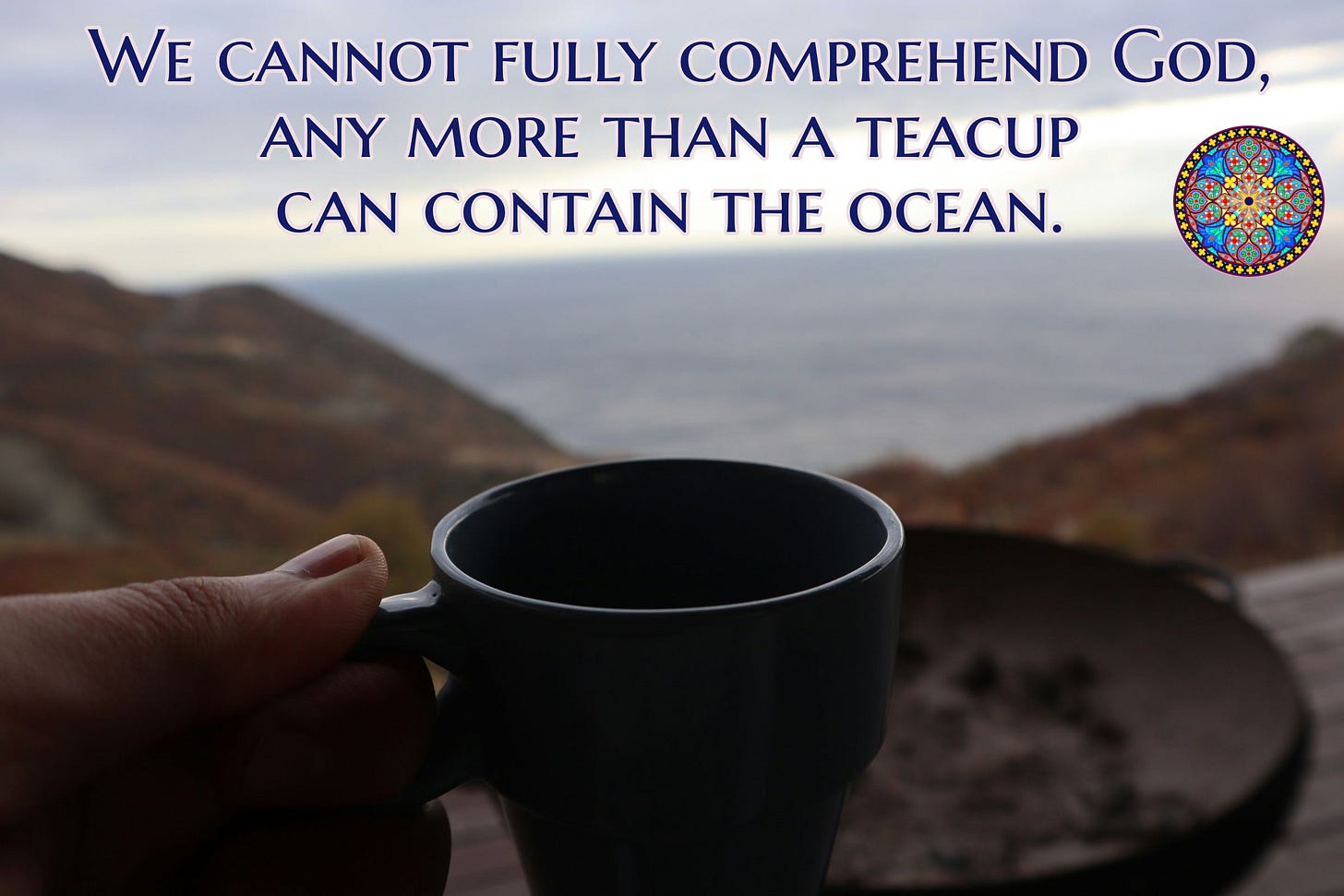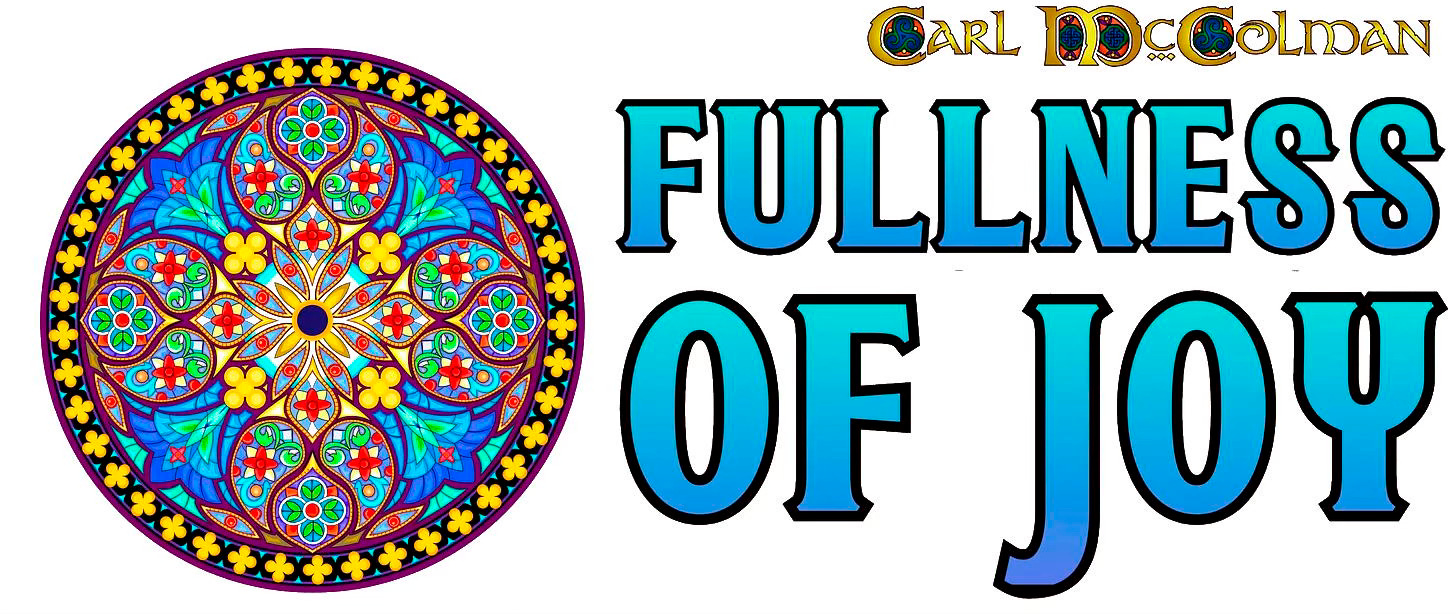The Ocean and the Teacup
We Meet the Mystery in Silence, for Words Always Fall Short.
As a blogger, nothing delighted me more than having a reader write in with a comment or a question. Often, I would be inspired to respond tot the reader’s feedback with a new blog post, directly answering their questions or criticisms, hopefully in a friendly way.
Now that I am sharing new writing primarily here on Substack, I hope we can continue to have some interactive dialogue. Please let me know if you have something to say about something I’ve written, and especially if you have a question for me. Paid subscribers can post comments directly to a post, but any subscriber can communicate directly with me simply by replying to the email newsletter Substack sends you (and if you aren’t currently a subscriber, you can always reach me just by sending an email to anamchara@substack.com.
Meanwhile, here’s my first bit of Substack reader feedback, in response to my post Defining the Indefinable. A reader writes:
For me, the biggest stumbling block to wrapping myself around the concept of 'God' is the continued reliance on personification of whatever we mean by 'God'.
Even in this article, there is a subtle reference to 'God' as a person that I wondered about.
When you think of 'God' do you have a sense of it being a person, or what is your image?
I think of 'god' as GOOD, instead of God, and my image is more of a swirling energy of dust like the pics of faraway galaxies.
This energy of 'good' can be tapped into and activated by love.
It has the power to create and move us to being the highest humans we can be, as taught by many wise people, like Jesus etc.
I know, for many fundamentalists, that personification of God is part of their belief. The 'old man in the clouds' understanding.
I was brought up in a liberal church in Canada that still subtly continued that concept in the 50s to 70s.
It made no sense to me, so I left the church.
Thanks for some insightful comments. I love your image of God as the energy of good, swirling like galaxies and accessible by love!
And as you were able to discern, I myself am basically okay with using a personalist image of God, although I tend to resist the Gandalf-in-the-sky bit.
Human beings cannot fully comprehend God, any more than a teacup can contain the ocean. The interesting question is, what language, what imagery, what symbolism and metaphors, are the most helpful for us when we try to squeeze the ocean of God into the teacups of our brains?
A lot of traditional God-talk uses personalist or personifying or anthropomorphizing language to speak of God, presenting God as a kind of infinite-daddy (or momma) in the heavens. This is the language that presents God as having a personality, the ability to speak and listen, and as behaving (on a universal level) in a manner similar to how human beings behave on a more down-to-earth level.
Not everyone finds this kind of language helpful or meaningful. Many people see a personalist God as a kind of limitation of the Divine, trying to squeeze the Divine infinity into a constrained human concept. The ocean and the teacup, again. Such people often prefer an impersonalist image of God, where God is simply a name for a kind of heavenly energy, or for the Spirit of Love, or perhaps even the Force as depicted in Star Wars. This God may seem more truly infinite than the God-the-Father image, but might also be harder for many people to relate to. It’s easier to fall in love with a person — even a person bigger than the cosmos — than it is to fall in love with a “field” or “force” of energy.
I remember the first time a Trappist monk bluntly said to me, “I’m an impersonalist” — what he meant was that he simply could not relate to any image of God that depicted God in anthropomorphic ways. This monk was a true mystic, deeply contemplative, and profoundly kind and loving. But he wasn’t the kind of person to speak about concepts like “God’s purpose for me” or “God’s forgiving mercy” or anything like that. His God was compassionate and kind, but also utterly silent.
I also remember another friend, who for many years taught at a seminary here in Georgia; he was well-read, theologically sophisticated, and quite liberal in both his political and religious values. He was deeply committed to interfaith work and to caring for those who are in need. He also always spoke of God using the kind of personalist, intimate language that suggested for him, God was not only the Source of Love, but was truly a caring conscious Supreme Being who actively desired a relationship with each and every sentient being.
Becuase of my experience with that seminary professor, I do feel like I need to protest the idea that a personified God is only meaningful to fundamentalists. I have known plenty of people whose theology is most definitely not fundamentalist and yet who speak about God using personalist language. Fundamentalism is something other than just a way of talking about God; it is a level of consciousness that demands obedience to authority, strict conformity, hostility or fear toward outsiders, and a dualistic, black-and-white understanding of how reality is structured.
In my experience, it does seem that fundamentalists tend to hold a personalist image of God — but it’s also my experience that some people grow beyond fundamentalism and yet still find meaning and intimacy in relating to God in a personified way (like my friend the seminary professor). Maybe the important lesson here is simply “do not judge” — let other people relate to God in the manner that works for them, and our job is simply to concentrate on discovering the best image of God that works for ourselves. Remembering, always, that our teacups just can’t hold the entire ocean.
I feel like I ought to directly answer my reader’s question. She asked: When you think of 'God' do you have a sense of it being a person, or what is your image?
There are several images of God I find meaningful.
God is pure love: Love with a capital L.
But because God is Love, and Love is the heart of relationship, I find it hard to relate to God as an “it.” Of course, our normal personal pronouns, he, she, they, all seem to fail as well.
To my mind, it’s just as limiting for God to be seen as impersonal as it is limiting to speak of God as a person. But having said that, what I myself imagine God to be largely seems to rely on impersonal images, images that are mostly anchored in nature/the universe:
God is an ocean: the ocean of infinite love, kindness, compassion and mercy;
God is infinite silence, but not silence as an absence, rather silence as a presence;
God is pure consciousness, infinite awareness, immediate presence, ever-flowing love, vast and lavish compassion.
God is the ground of being: so the page on which all words are printed, the darkness into which all stars emerge, the chalice into which human consciousness and awareness is poured.
And of course: God is Mystery, ultimate mystery, infinite mystery, playful mystery, affectionate mystery.
I could go on, but hopefully this gives you a sense.
Even with all these impersonalist images, I have no problem talking about God using personalist language — at least to a limited extent. “God loves us all” or “God is on the side of justice” are meaningful statements to me. “God is an old white dude with long white hair and a beard” — that doesn’t really work, though.
I think that kind of sky-daddy or sky-mommy imagery is most useful for small children, who have not developed much capacity for abstract thinking; churches and parents can use this kind of language when teaching the little ones, but we need to do a better job at helping older children, teenagers and young adults to make the transition from sky-daddy to a more universal (abstract) conception of the Divine Mystery. Indeed, I believe churches are at fault when they don’t actively help teenagers and young adults to let go of such immature images. We need to jettison the patriarchal God at about the same developmental age as when we figure out that Santa Claus and the Easter Bunny are myths.
And perhaps that’s not a bad analogy. Letting go of Santa Claus — the elf who visits every single home on Christmas Eve, eating up all the cookies and leaving tons of presents — is an important milestone in the development of a child’s critical mind. But I hope that when kids let go of Santa Claus, they can still hold on to all the beautiful concepts and values that Santa represents: generosity, family love, abundance, trust that the winter will always yield to spring. There’s plenty of talk about “the Spirit of Christmas” that is important to hold on to, even as the myth of Father Christmas must be set aside.
Maybe our developmental relationship with God works (or should work) the same way. We need to let go of the myth of Gandalf-in-the-Sky, but does that mean we should also give up on the idea that there is Something in our universe that is the source of love, compassion, creativity and community? Many atheists would say yes, we should give up such mythological ideas — but I think that’s short-sighted and even dualistic. “God,” as a linguistic signifier, invites us to a place where myth is the key to spiritual understanding, and part of what makes a myth a myth is that it is both true and not-true at the same time. God is the Spirit of Creativity and Love in the same way that Santa is the Spirit of Christmas. Both are mythic, which means both are spiritually and mystically real even if they are also “not real” in any kind of rational/linguistic sense. Our language cannot contain God, which is why none of the pronouns work, and why every image of God seems to be an obstacle to God just as much as it can also be an icon of God.
I realize that many people might find this post dissatisfying. True believers will be annoyed by my understanding of God (and spiritual truth in general) as primarily mythological realities, but many others (including many mystics and contemplatives) will chafe against my serene acceptance of personalist language. But I accept that language precisely because I understand it as mythological. In other words, I give the personified God freedom to both exist and not exist. And in that freedom, I find the space to relate to God as that which invites me ever more deeply into love and justice and compassion and joy and higher consciousness and insight and wisdom. It really doesn’t matter to me if you want to talk about that God using personalist language or not. All language is a distortion and carries infinite shades of meaning. That’s the understanding we need to keep in mind whenever we talk about God, and whatever imagery we might find helpful in our understanding of God. If an image works for you, use it. But try to remember that image won’t work for everyone — and the image that doesn’t work for you just might be the very image that helps another person’s spirit to soar.
A few final words to my reader: reviewing your email, I appreciate how you acknowledge that personalist language about God is “a stumbling block” and that it “makes no sense” to you. I wonder if you might have some unhappy memories of people who used that kind of language about God relating to you in judgmental, controlling, or even abusive ways. In other words, I think the language we use to describe God, whether personalist or impersonalist, is itself morally and spiritually neutral; but if the people who use that language behave in ways that are hurtful, controlling, or traumatizing to us, then we will associate this neutral language with harmful actions, and it may leave us uncomfortable with that language for life. My point is simple: when someone speaks about God in a way that bothers us, sometimes that is an invitation for us to do some inner work and find healing within ourselves; we may never choose to think or talk about God using that kind of language, but hopefully we can reach the point where it won’t bother us if other people prefer to talk about God that way. It’s a process of doing our own interior growth, to that we can treat others with respect and kindness, even when their values may be different from our own.
Celtic Clipart by Cari Buziak, used by permission.







